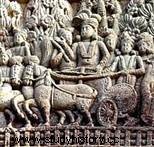 From the beginning of the third millennium BC, invaders and colonizers from Central Asia challenged the passes of Himalayas to settle in the Indus Valley . Among the cradles of agriculture, these brilliant civilizations of northern India contemporaries of Pharaonic Egypt and the Mesopotamian civilization gave birth to two great religions, Hinduism and Buddhism. Long forgotten, they have been rediscovered thanks to archaeological excavations carried out since 1920.
From the beginning of the third millennium BC, invaders and colonizers from Central Asia challenged the passes of Himalayas to settle in the Indus Valley . Among the cradles of agriculture, these brilliant civilizations of northern India contemporaries of Pharaonic Egypt and the Mesopotamian civilization gave birth to two great religions, Hinduism and Buddhism. Long forgotten, they have been rediscovered thanks to archaeological excavations carried out since 1920.
The Harappan civilization, the first civilization of the Indus
South Asia's first civilization flourished in the floodplain of the Indus River in present-day Pakistan. This region has strong similarities to Mesopotamia - a hot and dry climate, but fertile soil and abundant water. Agriculture did not take long to spread there and, from 2600 BC. J.-C., many villages dotted the plain, some of which had already turned into large agglomerations, even small towns.
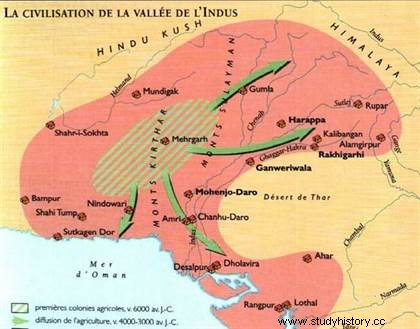 It was in the 1920s that archaeologists began excavations in the Indus Valley. Two sites in particular; Mohenjo-Daro and Harappa, delivered the first indications of the existence of a highly urbanized civilization, dating back more than 4000 years and easily rivaling its contemporaries in Mesopotamia and the Nile Valley. These two cities and a few others, whose extent seemed to exceed the other populated sites of the region, were undoubtedly royal capitals.
It was in the 1920s that archaeologists began excavations in the Indus Valley. Two sites in particular; Mohenjo-Daro and Harappa, delivered the first indications of the existence of a highly urbanized civilization, dating back more than 4000 years and easily rivaling its contemporaries in Mesopotamia and the Nile Valley. These two cities and a few others, whose extent seemed to exceed the other populated sites of the region, were undoubtedly royal capitals.
The unearthed remains bear witness to an extremely well-organized civilization. Cities and towns were designed according to a checkerboard plan; while social classes and professions were grouped by neighborhoods. Raised on mud-brick platforms to protect against flooding, the urban centers were equipped with a sophisticated water supply and sewage system.
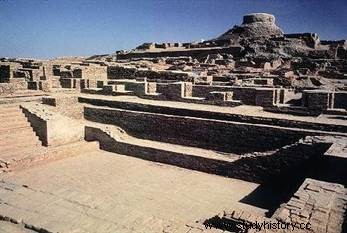 On the other hand, we have only rare information on this building people. Although stone seals engraved with pictograms have been found, its writing retains all its mystery, and its language remains unknown to us. It was nevertheless established that the inhabitants of the Indus maintained commercial relations with distant countries, both within the subcontinent and along the Persian Gulf, and as far as Mesopotamia.
On the other hand, we have only rare information on this building people. Although stone seals engraved with pictograms have been found, its writing retains all its mystery, and its language remains unknown to us. It was nevertheless established that the inhabitants of the Indus maintained commercial relations with distant countries, both within the subcontinent and along the Persian Gulf, and as far as Mesopotamia.
The Indus civilization began its decline around 1800 BC. A century later, the cities were abandoned. The reasons for this disappearance remain obscure. The hypothesis of an invasion was ruled out, life in rural areas having undergone no change. On the other hand, it is likely that climate change or some other natural disaster played a decisive role in this desertion.
Vedic India and New Beliefs
Around 1500 BC. AD, the Aryans of Central Asia migrated to northern India. Originally semi-nomadic and cattle herders, they settled around 1000 BC. J.-C. in the vast fertile plain of the Ganges - which stretches over 3,000 km from west to east, in the north of the subcontinent - in order to cultivate rice. By this time, the Aryans had already acquired the use of iron; probably independently.
The Aryas wielded considerable influence in the history of India. Many of the languages spoken today in the country come from Sanskrit, their idiom. Hinduism, currently the most widespread religion in the subcontinent, has its origins in their belief. The Vedas, the first sacred Hindu texts, consist of songs recounting the mythical history of Aryan migrations and wars, under the aegis of the god Indra.
Hinduism is largely based on the caste system, a hereditary social categorization. He comes from the four vamas, or classes, that once ruled Aryan society. At the top of the hierarchy stood the Brahmins, or priests, and the feshatriyas, the warriors. Then came the Vaishyas—peasants and merchants—and, at the lower level, the Shudras, who brought together artisans, workers, and slaves. the kings traditionally belonged to the warrior caste, while being vested with important religious functions, including the performance of earth fertility rituals.
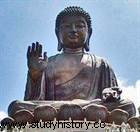 In 500 BC. AD, Hinduism had spread throughout the Indian subcontinent. The Brahmans had evolved into a power class, and the questioning of their role favored the emergence of new sects, such as Jainism (still widely practiced in India) and Buddhism. The latter was founded by Siddharta Gautama (v. 563-483 BC), whose teachings were disseminated in the plain of the Ganges and its surroundings. However, Buddhism only really became popular during the reign of Emperor Ashoka, from 268 to 233 BC. AD
In 500 BC. AD, Hinduism had spread throughout the Indian subcontinent. The Brahmans had evolved into a power class, and the questioning of their role favored the emergence of new sects, such as Jainism (still widely practiced in India) and Buddhism. The latter was founded by Siddharta Gautama (v. 563-483 BC), whose teachings were disseminated in the plain of the Ganges and its surroundings. However, Buddhism only really became popular during the reign of Emperor Ashoka, from 268 to 233 BC. AD
The reign of Emperor Ashoka
Ashoka was the third ruler of the Maurya dynasty, inaugurated by his grandfather, Chandragupta, who reigned from 321 to 293 BC. An able administrator and an accomplished soldier, Chandragupta made a name for himself commanding troops in northwestern India at the time of Alexander the Great's invasion of the Indus Valley. Then he seized Magadha, the most influential kingdom of the Ganges plain. At the head of a powerful central government, he built roads, irrigation systems and other public facilities. Chandragupta eventually subdued almost all of northern India. His son, Bindusara, who exercised power from 293 to 268 BC. J.-C., extended the Maurya sphere of influence to the Deccan, the plateau in the center of the country.
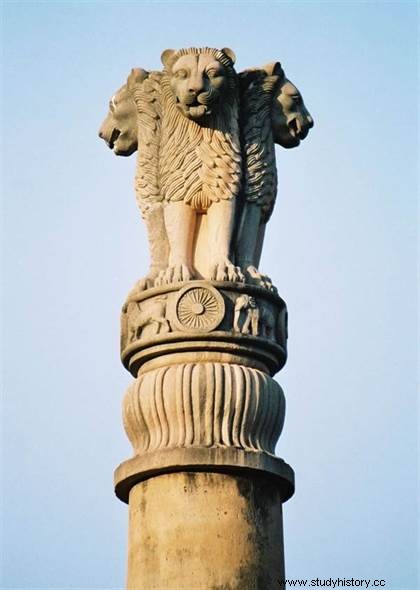 Ashoka began his reign by conquering Kalinga in eastern India. However, horrified by the suffering caused by the war, Ashoka converted to Buddhism and placed his life under the sign of non-violence. The new follower let neighboring heads of state know that he would never attack them, gave up hunting and became a vegetarian.
Ashoka began his reign by conquering Kalinga in eastern India. However, horrified by the suffering caused by the war, Ashoka converted to Buddhism and placed his life under the sign of non-violence. The new follower let neighboring heads of state know that he would never attack them, gave up hunting and became a vegetarian.
At Ashoka's orders, Buddha's teachings were engraved on rocks and stone stelae all over India. He sent missionaries to Ceylon, Indonesia and Central Asia, where Buddhism enjoyed considerable success, and as far as Syria, Egypt and Anatolia. Ira religious tolerance was also part of the precepts advocated by Ashoka. In India, many converted to Buddhism. However, the majority of Indians continued to devote themselves to traditional Hindu worship in peace.
The Mauryan Empire began its decline with the death of Ashoka. In 185 BC. BC, it was divided into several independent states. They offered little resistance to the new invaders from Central Asia, the Sakas (related to the Scythians). Then came the Rushans, who took control of a string of territories to the north. They developed trade with China, Persia and Rome. These new arrivals, adopting the language and the religion of their subjects, completely assimilated the Indian culture. At this time, flourishing ports and independent kingdoms began to emerge in southern India, thanks to the development of maritime trade routes.
To go further
- The Forgotten Cities of the Indus:Archeology of PakistanThe Forgotten Cities of the Indus:Archeology of Pakistan. Guimet Museum, 2008.
- India and the Invasion from Nowhere:The Last Lair of the Aryan Myth, by Michel Danino. Les Belles Lettres, October 2006.
